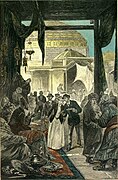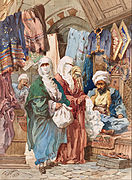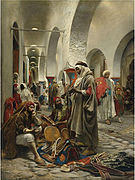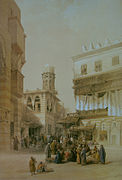Bazaar

Abazaar[a]orsouk[b]is a marketplace consisting of multiple smallstallsor shops,[1]especially in theMiddle East,[2][1]theBalkans,North AfricaandSouth Asia.[1]They are traditionally located in vaulted or covered streets that had doors on each end and served as a city's central marketplace.[3]
The termbazaaroriginates fromPersian,where it referred to a town's public market district.[4]The term bazaar is sometimes also used to refer collectively to themerchants,bankersandcraftsmenwho work in that area. The termsoukcomes fromArabicand refers to marketplaces in the Middle East and North Africa.[5]
Although the lack of archaeological evidence has limited detailed studies of the evolution of bazaars, the earliest evidence for the existence of bazaars or souks dates to around 3000BCE.Cities in the ancient Middle East appear to have contained commercial districts. Later, in the historicIslamic world,bazaars typically shared in common certain institutions, such as the position of themuḥtasib,and certain architectural forms, such as roofed streets and courtyard buildings known in English ascaravanserais.The exact details of their evolution and organization varied from region to region.
In the 18th and 19th centuries, Western interest inorientalculture led to the publication of many books about daily life in Middle Eastern countries. Souks, bazaars and the trappings of trade feature prominently in paintings and engravings, works of fiction and travel writing.
Shopping at a bazaar or market-place remains a central feature of daily life in many Middle-Eastern and South Asian cities and towns and the bazaar remains the beating heart ofWest AsianandSouth Asianlife; in the Middle East, souks tend to be found in a city's old quarter. Bazaars and souks are often important tourist attractions. A number of bazaar districts have been listed asUNESCO World Heritage Sitesdue to their historical and/or architectural significance.
Terminology
[edit]Bazaar
[edit]
The origin of the word "bazaar" comes fromNew Persianbāzār,[6][7]fromMiddle Persianwāzār,[8]fromOld Persianwāčar,[9]fromProto-Indo-Iranian*wahā-čarana.[10]The term spread from Persian into Arabic, now used throughout the Middle East and in the Indian subcontinent.[11]
In North American and Europe, the English word "bazaar" can denote more generically a shop or market selling miscellaneous items. It can also refer in particular to a sale orfairto raise money forcharitablepurposes (e.g.charity bazaar).[12][13][11]
Variations
[edit]InTurkish,the word was borrowed aspazar,but it refers to an outdoor market held at regular intervals, not a permanent structure containing shops. English place names usually translate "çarşı" (shopping district in a downtown or downtown itself) as "bazaar" when they refer to an area with covered streets or passages.[citation needed]
Souk
[edit]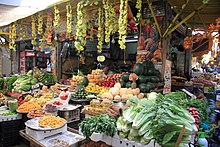
The word "souk" in the Arabic-speaking world is roughly equivalent to "bazaar".[14]The Arabic word is a loan fromAramaic"šūqā" ( "street, market" ), itself a loanword from theAkkadian"sūqu" ( "street" ).[15][16]The Arabic wordsūqwas then borrowed into English via French (souk) by the 19th century.[17][18]The English word can also be spelled "suq" or "souq".[19][20]
InModern Standard Arabicthe termal-sūqrefers to markets in both the physical sense and the abstracteconomicsense (e.g., an Arabic-speaker would speak of thesūqin the old city as well as thesūqfor oil, and would call the concept of thefree marketالسوق الحرّ,as-sūq al-ḥurr).
Variations
[edit]In northern Morocco, the Spanish corruptionsoccois often used as in theGrand SoccoandPetit SoccoofTangiers.[21][22][23]

InIsrael,the termshukorshuq(Hebrew:שׁוּק,romanized:šūq) shares a commonAramaicorigin of theArabicsouk,and holds a prominent role in everyday life.[citation needed]Markets such asMahane YehudainJerusalemare often covered rows of stalls much like those seen elsewhere in the region, selling produce, spices,halvah,and even clothing.
History
[edit]Origins in antiquity
[edit]Scholar Mohammad Gharipour has pointed out that in spite of the centrality of souks and bazaars in Middle Eastern history, relatively little is known due to the lack of archaeological evidence.[24]Historical records document the concept of a bazaar existing in Iran as early as 3000 BCE, where some large cities contained districts dedicated to trade and commerce.[25][26]Archeological data also suggests the existence of market districts in ancientMesopotamia.[26]Markets centers must have existed inEgyptto conduct international trade, but no archeological evidence for them has been found.[26]InAchaemenidPersia (550–330 BCE), documents indicate that crafts were sold in markets close to Persepolis.[26]A network of bazaars had sprung up alongside ancient caravan trade routes. Bazaars located along these trade routes, formed networks, linking major cities with each other and in which goods, culture, people and information could be exchanged.[27]Sources from around the same era also indicate that ancient Greeks regulated trade in areas at the center of their cities aroundstoabuildings. The ideas of Greek city planning were spread to the Middle East during theSeleucidperiod, following theconquestsofAlexander the Great.[26]
The Greek historian,Herodotus,noted that in Egypt, roles were reversed compared with other cultures and Egyptian women frequented the market and carried on trade, while the men remain at home weaving cloth.[28]He also describedThe Babylonian Marriage Market.[29][relevant?]
Sassanid rulein Iran was an important period for the development of urbanization and commerce.[30]In Sassanid Iran the bazaar was usually the heart of a town or city, where it spread outwards and affected the development of other neighbourhoods. The bazaar usually contained, or was adjoined by, an open-air plaza that served as a forum of socio-economic activity.[30]
Historically, souks were also held outside cities at locations where incoming caravans stopped and merchants displayed their goods for sale.[citation needed]Souks were established atcaravanserai,places where a caravan or caravans arrived and remained for rest and refreshments. Since this might be infrequent, souks often extended beyond buying and selling goods to include major festivals involving various cultural and social activities. Any souk may serve a social function as being a place for people to meet in, in addition to its commercial function.[31]
In pre-Islamic Arabia, two types of bazaar existed: permanent urban markets and temporary seasonal markets. The temporary seasonal markets were held at specific times of the year and became associated with particular types of produce. Suq Hijr in Bahrain was noted for its dates while Suq 'Adan was known for its spices and perfumes. In spite of the centrality of the Middle East in the history of bazaars, relatively little is known due to the lack of archaeological evidence. However, documentary sources point to permanent marketplaces in cities from as early as 550 BCE.[24]
Islamic period
[edit]
According to traditional Muslim narratives,Muhammadestablished a market place (sūq) inMedinashortly after arriving there during theHijrahin 622 CE. He designated an open, unbuilt space as the market area and forbade both the construction of permanent structures and the levying of taxes in this area.[14]Eight years later, he is said to have appointed a market inspector ('āmil 'alā l-sūq), a position that likely evolved into the latermuḥtasibin Islamic cities, an official in charge of overseeing public morality and regulating weights and measures.[14]
Despite the importance of the bazaar to economic life and the prominence of marketplace terminology in theQuran,not much is known about the early history of bazaars and it remains a topic of ongoing research.[14]Most of the surviving urban commercial structures in the Islamic world date from the 16th century or later, though some preserved urbancaravanserais(commonly known as afunduq,khān,orwakāla) date from earlier periods.[32]The oldest of these is theKhan al-Mirjanin Baghdad, built in 1359 as part of a larger architectural complex.[33]
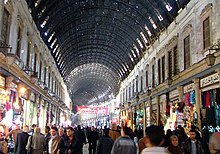
Muhammad's prohibition against constructing permanent buildings and levying taxes in the market began to be disregarded as early as theUmayyad period(7th to 8th centuries). The Umayyad caliphsMu'awiya IandHisham ibn Abd al-Malikboth built structures in the market of Medina and levied taxes there, while purpose-built markets were built in early Islamic cities further abroad such asBasrainIraq,Fustatin Egypt, andKairouanin Tunisia. This process seems to have accelerated during the reign of Hisham ibn Abd al-Malik (r. 724–743) in particular.[14]Markets that sold the most important or expensive goods were usually located near the city's centralFriday mosque.[14]In some cities, such as Cairo and Aleppo, the main bazaar was initially focused along one important street and then progressively grew and branched off into the surrounding streets.[32]
During the Islamic period in Iran, bazaars developed along the same lines as those of the Sassanid period.[30]Up to the 11th century, the bazaar developed more commonly in the suburbs outside the city walls that enclosed theshahristān,the formal city. This was especially true in Central Asia, though there were exceptions in some regions where the bazaar was grouped with the citadel and the city's Friday mosque inside the city walls.[34]After the 11th century, the growing importance of the suburbs and the commercial districts resulted in most of them being enclosed within newly expanded city walls. From the 10th century onward, the bazaar became the financial center of a city and was heavily patronized and developed by ruling elites. The grouping of a bazaar, citadel, and Friday mosque also became more common.[34]
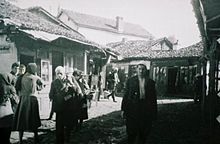
In theMamluk Sultanate(13th to 16th centuries) and in theOttoman Empire(14th to 20th centuries), the construction of commercial buildings in and around the bazaar was often sponsored by sultans, ruling elites, or by members of theOttoman royal family.The revenues generated by these buildings were typically earmarked to support the upkeep of religious complexes sponsored by these same patrons, through the legal framework of awaqf(legal endowment).[35][36][37]
21st century
[edit]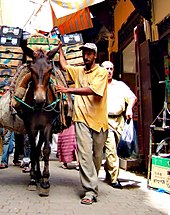
In the Middle East, the bazaar is considered to be "the beating heart of the city and a symbol of Islamic architecture and culture of high significance."[38]Today, bazaars are popular sites for tourists and some of these ancient bazaars have been listed as world heritage sites or national monuments on the basis of their historical, cultural or architectural value.
TheMedina of Fez,Morocco,which includes numerous long market streets (e.g.Tala'a Kebira) and bazaar areas (e.g.Kissariat al-Kifah), was listed as aUNESCO World Heritage Sitein 1981.[39]Al-Madina Soukin Aleppo is the largest covered historic market in the world, with an approximate length of 13 kilometers.[40][additional citation(s) needed]It is part of theAncient Aleppo,a UNESCO World Heritage Site since 1986 inSyria.[41]TheBazaar complexinTabriz,Iran, was listed by UNESCO in 2010.[42]The Bazaar of Qaisiyariye inLar, Iran,is on the tentative list of UNESCO World Heritage Sites since 2007.[43]KemeraltıBazaar inİzmirwas placed on tentative list in 2020.[44]
Organization and institutions
[edit]| Part ofa serieson |
| Arabic culture |
|---|
 |
Shopping at a souk or market place is part of daily life throughout much of the Middle East.[45]Prices are commonly set bybargaining,also known as haggling, between buyers and sellers.[46]
Bazaars or souks are traditionally divided into specialized sections dealing in specific types of product, each usually housed in a few narrow streets and named after the product it specializes in such as thegold souk,the texitle souk, the spice souk, the leather souk, the booksellers' souk, etc. This promotes competition among sellers and helps buyers easily compare prices.[47]Merchants specialized in each trade were also organized intoguilds,which provided support to merchants but also to clients. The exact details of the organizations varied from region to region. Each guild had rules that members were expected to follow, but they were loose enough to allow for competition. Guilds also fulfilled some functions similar totrade unionsand were able to negotiate with the government on behalf of merchants or represent their interests when needed.[47]
Though each neighbourhood within the city would have a local souk selling food and other essentials, the main bazaar was one of the central structures of a large city, selling durable goods, luxuries and providing services such as money exchange. Workshops where goods for sale are produced (in the case of a merchant selling locally-made products) are typically located away from the souk itself.
Historically, in Islamic cities, themuḥtasibwas the official in charge of regulating and policing the bazaar and other aspects of urban life. They monitored things such as weights and measures, pricing, cleanliness, noise, and traffic circulation, as well as being responsible for other issues of public morality.[14][47]They also investigated complaints about cheating or the quality of goods.[47]The equivalent official could be known by other titles in different regions, such as thekedkhodain Istanbul or theamir-i bazariyaninDelhi.In theMaghreb(northwestern Africa), themuḥtasibalso shared responsibilities with other officials such as theqadior thehakim.[47]
Layout and architecture
[edit]
Permanent bazaars were established in urban zones, usually within thecity wallsand close to the heart of the city. In much of the Middle East and North Africa, the bazaar is a network of interconnected spaces, including streets and buildings, with diverse architectural forms. Its boundaries are not sharply defined and can vary according to circumstance, as the bazaar is closely integrated with its urban surroundings and with other important institutions of the city.[14]
Although there is great variety among the bazaars of this region, there are three recurring elements, in addition to the general network of market streets. One element is the individual shops or booths that line each side of a market street. The shops are usually small spaces open to the street and occupied by merchants. They are typically equipped with large shutters which can be closed and locked when the shopkeeper is away.[14]Another element is a more secure market area, usually centrally located and consisting of streets that were covered or roofed. This complex is variably known as aqayṣariyya,bedesten,orkhān,depending on the city or historical period. It usually hosted the most prestigious and profitable trades such as jewelry, perfumes, and textiles. In order to protect these goods, the entrances to this area could be closed and locked at night or in times of danger.[14]The other recurring element is the presence of courtyard buildings entered via a single large doorway. Often translated into English as acaravanserai,this type of building is known in different regions as afunduq,khān,samsara,orwakāla.They could serve a variety of functions including an inn for travelers and merchants, a manufacturing center, a trade venue, or a warehouse.[14]
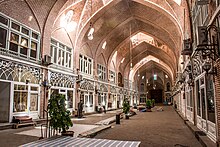
In Iran and Central Asia, the permanent bazaar is likewise in the centre of a city and had common architectural elements. These bazaars acted as financial centers of the city and were traditionally overseen by the state.[34]Some Iranian bazaars are organized around one long market street from which other market streets branch off (e.g. in Isfahan or Tehran), while others are large rectangular zones with a grid-like network of parallel and intersecting streets (e.g. as in Tabriz).[34]The streets are lined with structures of one or two storeys that contain spaces for shops. The streets are typically roofed with brick vaults, pierced by skylights to allow for light and air circulation. The shops are often adjacent or connected to the workshops where the goods are also produced, so that manufacturing and retail are often concentrated in the same areas, though some production (especially of textiles) was also distributed in other parts of the city.[34]Like the bazaars further west, there were also manykhāns (caravanserais) built in the area. They acted as warehouses, production centers, wholesale centers, hostels for merchants, and offices for conducting business.[34]

In the cities that developed under the Ottoman Empire, there was generally one central bazaar area, known in Turkish as theçarşı.TheGrand BazaarinIstanbul,known locally as theKapalıçarşı('covered market'), is a famous example. Additionally, several types of market structures were common: thebedesten,thearasta,and thehan(Turkishcognateofkhān).[35]TheOttomanbedestenwas a solid stone building, typically rectangular and roofed by domes, with shops inside. Like theqayṣariyyaorbedestenin other regions, it hosted the most important and luxurious trades.[35]Thearastais usually an elongated market structure or market street with shops lining its façades.Arastas could be independent markets built outside the main bazaar area, such as those built as part of large religious complexes like theSelimiye Mosque complexinEdirneor theSultanahmet Mosque complexin Istanbul. TheSpice BazaarorMısır Çarşısı('Egyptian Market') in Istanbul is also one of the largest and best-known examples.[35]Thehanis similar in function to otherkhānor caravanserai buildings elsewhere, with a courtyard enclosed by two storeys. The ground floor was usually used for storage and for stabling horses, while the upper floor housed merchants.[35]
Temporary souks
[edit]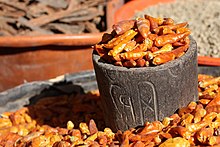
A temporary, seasonal souk is held at a set time that might be yearly, monthly or weekly. The oldest souks were set up annually, and were typically general festivals held outside cities. For example, Souk Ukadh was held yearly in pre-Islamic times in an area betweenMeccaandTa’ifduring the sacred month ofDhu al-Qi'dah.While a busy market, it was more famous for its poetry competitions, judged by prominent poets such asAl-KhansaandAl-Nabigha.An example of an Islamic annual souk isAl Mirbidjust outsideBasra,also famed for its poetry competitions in addition to its storytelling activities.[48]Temporary souks tended to become known for specific types of produce. For example, Suq Hijr in Bahrain was noted for its dates while Suq 'Adan was known for its spices and perfumes.[49]Political, economic and social changes have left only the small seasonal souks outside villages and small towns, primarily selling livestock and agricultural products.
Weekly markets have continued to function throughout the Arab world. Most of them are named from the day of the week on which they are held. They usually have open spaces specifically designated for their use inside cities. Examples of surviving markets are the Wednesday Market inAmmanthat specializes in the sale of used products, theGhazlmarket held every Friday inBaghdadspecializing in pets; the Fina’ Market inMarrakechoffers performance acts such as singing, music, acrobats and circus activities.
In tribal areas, where seasonal souks operated, neutrality from tribal conflicts was usually declared for the period of operation of a souk to permit the unhampered exchange of surplus goods. Some of the seasonal markets were held at specific times of the year and became associated with particular types of produce such as Suq Hijr in Bahrain, noted for its dates while Suq 'Adan was known for its spices and perfumes. In spite of the centrality of the Middle Eastern market place, relatively little is known due to the lack of archaeological evidence.[24]
In art and literature – Orientalism
[edit]During the 18th and 19th centuries, Europeans conquered and excavated parts of North Africa and the Levant. These regions now make up what is called the Middle East, but in the past were known as theOrient.Europeans sharply divided peoples into two broad groups – theEuropean Westand theEast or Orient;usand theother.Europeans often saw Orientals as the opposite of Western civilization; the peoples could be threatening- they were "despotic, static and irrational whereas Europe was viewed as democratic, dynamic and rational."[50]At the same time, the Orient was seen as exotic, mysterious, a place of fables and beauty. This fascination with the other gave rise to a genre of painting known asOrientalism.A proliferation of both Oriental fiction and travel writing occurred during the early modern period.
Subject-matter
[edit]Many of these works were lavishly illustrated with engravings of every day scenes of Oriental lifestyles, including scenes of market places and market trade.[51]Artists focused on the exotic beauty of the land – the markets, caravans and snake charmers. Islamic architecture also became favorite subject matter. Some of these works were propaganda designed to justify European imperialism in the East, however many artists relied heavily on their everyday experiences for inspiration in their artworks.[52]For example,Charles D'Oyly,who was born in India, published theAntiquities of Daccafeaturing a series of 15 engraved plates of Dacca [now Dhaka, Bangladesh] featuring scenes of markets, commerce, buildings and streetscapes.[53]European society generally frowned on nude painting – but harems, concubines and slave markets, presented as quasi-documentary works, satisfied European desires for pornographic art. The Oriental female wearing a veil was a particularly tempting subject because she was hidden from view, adding to her mysterious allure.[54]
Notable Orientalist artists
[edit]Notable artists in the Orientalist genre include: Jean-Léon Gérôme Delacroix (1824–1904),Alexandre-Gabriel Decamps(1803–1860),Frederic Leighton(1830-1896),Eugène Alexis Girardet1853-1907 andWilliam Holman Hunt(1827–1910) who all found inspiration in Oriental street scenes, trading and commerce. French painterJean-Étienne Liotardvisited Istanbul in the 17th century and painted pastels of Turkish domestic scenes. British painterJohn Frederick Lewiswho lived for several years in a traditional mansion in Cairo, painted highly detailed works showing realistic genre scenes of Middle Eastern life.Edwin Lord Weekswas a notable American example of a 19th-century artist and author in the Orientalism genre. His parents were wealthy tea and spice merchants who were able to fund his travels and interest in painting. In 1895 Weeks wrote and illustrated a book of travels titledFrom the Black Sea through Persia and India.Other notable painters in the Orientalist genre who included scenes of street life and market-based trade in their work are Jean-Léon Gérôme Delacroix (1824–1904),Alexandre-Gabriel Decamps(1803–1860),Frederic Leighton(1830–1896),Eugène Alexis Girardet1853–1907 andWilliam Holman Hunt(1827–1910), who all found inspiration in Oriental street scenes, trading and commerce.[55]
Orientalist literature
[edit]A proliferation of both Oriental fiction and travel writing occurred during the early modern period.[56]
Many English visitors to the Orient wrote narratives around their travels. British Romantic literature in the Orientalism tradition has its origins in the early eighteenth century, with the first translations ofThe Arabian Nights(translated into English from the French in 1705–08). The popularity of this work inspired authors to develop a new genre, the Oriental tale. Samuel Johnson'sHistory of Rasselas, Prince of Abyssinia,(1759) is mid-century example of the genre.[57]Byron'sOriental Tales,is another example of the Romantic Orientalism genre.[58]
Although these works were purportedly non-fiction, they were notoriously unreliable. Many of these accounts provided detailed descriptions of market places, trading and commerce.[59]Examples of travel writing include:Les Mysteres de L'Egypte DevoilesbyOlympe Audouardpublished in 1865[60]andJacques Majorelle'sRoad Trip Diary of a Painter in the Atlas and the Anti-Atlaspublished in 1922[61]
Gallery of paintings and drawings
[edit]-
TheMoorishBazaar,painting byEdwin Lord Weeks,1873
-
Street Scene in India,by Edwin Lord Weeks, circa 1885
-
Cashmere Travellers in a Street of Delhiby Edwin Lord Weeks, 1880s
-
Bazaar in Samarkand,illustration byLéon Benettfor aJules Vernenovel, 1893
-
The Bazaar,byAlexandre Defaux,1856
-
The Grand Bazaar,Istanbul,byAmadeo Preziosi,late 19th century
-
The Silk Bazaarby Amedeo Preziosi, late 19th century
-
Souk des étoffes,Tunis byAnton Robert Leinweber,before 1921
-
Carpet Merchant in the Khan el Khaleel,from Georg Ebers,Egypt: Descriptive, Historical, and Picturesque,Vol. 1, 1878
-
Inside the Souk,Cairo byCharles Wilda,1892
-
Bazaar of the Coppersmithsin Cairo by David Roberts, 1838
-
Bazaar El Moo Ristanin Cairo, by David Roberts, 1838
-
Timcheh Amin-o-Dowleh in theKashan Bazaar,Iran,c. 1800
List of bazaars and souks
[edit]See also
[edit]Types of markets, bazaars and souks:
- Haat bazaar– (also known as ahat) an open air bazaar or market in South Asia.
- Landa bazaar– a terminal market or market for second hand goods (South Asia), such asMedina quarter.
- Meena Bazaar– a bazaar that raises money for non-profit organisations.
- Pasar malam– a night market inMalaysia,IndonesiaandSingaporethat opens in the evening, typically held in the street in residential neighbourhoods.
- Pasar pagi– a morning market, typically a wet market that trades from dawn until midday, found in Malaysia, Indonesia and Singapore.
- Shōtengai- a style ofJapanesecommercial district, typically in the form of a local market street that is closed to vehicular traffic.
Markets and retail in general:
- Marketplace
- Shopping mall
- Arcade– a covered passageway with stores along one or both sides.
- History of marketing
Notes
[edit]- ^Persian:بازار,romanized:bâzâr;Arabic:بازار;Ottoman Turkish:پازار,romanized:pazar;Uzbek:bozor;Hindi:बाज़ार,romanized:bāzār;Punjabi:ਬਜ਼ਾਰ।,romanized:bazāra;Bengali:বাজার,romanized:bājār;Urdu:بازار,romanized:bazār;Kurdish:بازاڕ,romanized:bazar
- ^Arabic:سوق,romanized:sūq.In English, the word can also be spelledsouqorsuq.
References
[edit]- ^abc"bazaar".www.collinsdictionary.com.Archivedfrom the original on 2012-06-22.Retrieved2021-10-13.
- ^"bazaar".Lexico Dictionaries | English.Archived fromthe originalon 2021-04-17.Retrieved2021-10-13.
- ^"Bazaars and Bazaar Merchants | Encyclopedia.com".www.encyclopedia.com.Retrieved2021-10-13.
- ^"Bazaar | market".Encyclopedia Britannica.Retrieved2021-10-13.
- ^"souk".Merriam-Webster.Archivedfrom the original on 2009-04-22.Retrieved2021-10-13.
- ^"bazaar - Origin and meaning of bazaar by Online Etymology Dictionary".www.etymonline.com.Retrieved29 March2018.
- ^Ayto, John (1 January 2009).Word Origins.Bloomsbury Publishing. p. 104.ISBN978-1-4081-0160-5.
- ^Daryaee, Touraj (16 February 2012).The Oxford Handbook of Iranian History.Oxford University Press. p. 8.ISBN978-0-19-973215-9.
- ^"Bazaar".Dictionary.com, LLC.Retrieved11 March2015.
- ^Benveniste, Émile; Lallot, Jean (1 January 1973)."Chapter Nine: Two Ways of Buying".Indo-European Language and Society.University of Miami Press. Section Three: Purchase.ISBN978-0-87024-250-2.
- ^ab"bazaar".Britannica Money.2024-04-06.Retrieved2024-05-25.
- ^"bazaar".Oxford Learner's Dictionaries.Retrieved25 May2024.
- ^"Bazaar".Merriam-Webster Dictionary.Retrieved2024-05-25.
- ^abcdefghijkO'Meara, Simon (2011). "Bazaar, Arab lands". In Fleet, Kate; Krämer, Gudrun; Matringe, Denis; Nawas, John; Rowson, Everett (eds.).Encyclopaedia of Islam, Three.Brill.ISBN9789004161658.
- ^Corriente, Federico (2008).Dictionary of Arabic and Allied Loanwords: Spanish, Portuguese, Catalan, Galician and Kindred Dialects.Brill. p. 25.ISBN978-90-04-16858-9.
- ^Huehnergard, John (2021)."The Legacy of Akkadian".In Vita, Juan-Pablo (ed.).History of the Akkadian Language (2 vols).Vol. 2. Brill. p. 1506.ISBN978-90-04-44521-5.
- ^Harper, Douglas."Etymology of souk".Online Etymology Dictionary.Retrieved2024-05-25.
- ^Staff, Press Boulevard Company; Press, Oxford University; Staff, Oxford University Press (1999). "souk".The Oxford Essential Dictionary of Foreign Terms in English.Oxford University Press.ISBN978-0-425-16995-7.
- ^Hamza, Neveen (2022).Architecture and Urban Transformation of Historical Markets: Cases from the Middle East and North Africa.Taylor & Francis. p. 2.ISBN978-1-000-64546-0.
- ^Waite, Maurice (2012).Paperback Oxford English Dictionary.Oxford University Press. p. 695.ISBN978-0-19-964094-2.
- ^DK Eyewitness Morocco.DK. 2022.ISBN978-0-7440-8192-3.
- ^Shoemake, Josh (2013).Tangier: A Literary Guide For Travellers.I.B. Tauris.ISBN978-0-85773-376-4.
- ^Rivière, Paul-Louis (1908).Villes et solitudes: croquis d'Europe et d'Afrique(in French). Paris: Plon, Nourrit et Cie. p. 219.
Socco est l'altération espagnole du mot arabe souk (...)
- ^abcGharipour, Mohammad (2012). "Introduction – The Culture and Politics of Commerce: Bazaars in the Islamic world". In Gharipour, Mohammad (ed.).The Bazaar in the Islamic City: Design, Culture, and History.American University in Cairo Press. pp. 4–5.ISBN978-1-61797-346-8.
- ^Pourjafar, Mohammadreza; Amini, Masoome; Hatami Varzaneh, Elham; Mahdavinejad, Mohammadjavad (2014-03-01)."Role of bazaars as a unifying factor in traditional cities of Iran: The Isfahan bazaar".Frontiers of Architectural Research.3(1): 10–19.doi:10.1016/j.foar.2013.11.001.ISSN2095-2635.
- ^abcdeGharipour, Mohammad (2012). "Introduction – The Culture and Politics of Commerce: Bazaars in the Islamic world". In Gharipour, Mohammad (ed.).The Bazaar in the Islamic City: Design, Culture, and History.American University in Cairo Press. pp. 3–15.ISBN978-1-61797-346-8.
- ^Hanachi, Pirooz; Yadollahi, Solmaz (2011)."Tabriz Historical Bazaar in the context of change".ICOMOS Conference Proceedings.Paris, France: 1028–1039.
- ^Thamis (18 January 2012)."Herodotus on the Egyptians".World History Encyclopedia.Retrieved2023-06-15.
- ^Herodotus: The History of Herodotus,Book I (The Babylonians), c. 440BC, translated by G.C. Macaulay, c. 1890
- ^abcPourjafar, Mohammadreza; Amini, Masoome; Hatami Varzaneh, Elham; Mahdavinejad, Mohammadjavad (2014-03-01)."Role of bazaars as a unifying factor in traditional cities of Iran: The Isfahan bazaar".Frontiers of Architectural Research.3(1): 10–19.doi:10.1016/j.foar.2013.11.001.ISSN2095-2635.
- ^Gharipour, Mohammad (2012). "Introduction – The Culture and Politics of Commerce: Bazaars in the Islamic world". In Gharipour, Mohammad (ed.).The Bazaar in the Islamic City: Design, Culture, and History.American University in Cairo Press. pp. 14–15.ISBN978-1-61797-346-8.
- ^abM. Bloom, Jonathan; S. Blair, Sheila, eds. (2009). "Market, covered".The Grove Encyclopedia of Islamic Art and Architecture.Vol. 2. Oxford University Press. pp. 464–465.ISBN9780195309911.
- ^M. Bloom, Jonathan; S. Blair, Sheila, eds. (2009). "Caravanserai".The Grove Encyclopedia of Islamic Art and Architecture.Vol. 1. Oxford University Press. pp. 353–355.ISBN9780195309911.
- ^abcdefFloor, Willem (2011). "Bazaar, Iran and Central Asia". In Fleet, Kate; Krämer, Gudrun; Matringe, Denis; Nawas, John; Rowson, Everett (eds.).Encyclopaedia of Islam, Three.Brill.ISBN9789004161658.
- ^abcdeKuban, Doğan (2011). "Bazaar, Anatolia and the Balkans". In Fleet, Kate; Krämer, Gudrun; Matringe, Denis; Nawas, John; Rowson, Everett (eds.).Encyclopaedia of Islam, Three.Brill.ISBN9789004161658.
- ^Behrens-Abouseif, Doris (2007).Cairo of the Mamluks: A History of Architecture and its Culture.The American University in Cairo Press.ISBN9789774160776.
- ^Denoix, Sylvie; Depaule, Jean-Charles; Tuchscherer, Michel, eds. (1999).Le Khan al-Khalili et ses environs: Un centre commercial et artisanal au Caire du XIIIe au XXe siècle.Cairo: Institut français d'archéologie orientale.
- ^Karimi, M., Moradi, E. and Mehr, R., "Bazaar, As a Symbol of Culture and the Architecture of Commercial Spaces in Iranian-Islamic Civilization,"
- ^UNESCO,Medina of Fez,https://whc.unesco.org/en/list/170
- ^"eAleppo: The old Souks of Aleppo (in Arabic)".Esyria.sy.Retrieved2013-10-05.
- ^"eAleppo:Aleppo city major plans throughout the history"(in Arabic).
- ^UNESCO,Tabriz Historic Bazaar Complex,https://whc.unesco.org/en/list/1346
- ^Center, UNESCO World Heritage."Bazaar of Qaisariye in Laar - UNESCO World Heritage Center".whc.unesco.org.
- ^"Turkey's bazaar added to temporary UNESCO Heritage list".www.aa.com.tr.
- ^"Doha's Sprawling Souk Enters the Modern Era,The National[UAE edition], 25 February 2011, "https://www.thenational.ae/business/travel-and-tourism/doha-s-sprawling-souk-enters-the-modern-age-1.420872;Ramkumar, E.S., "Eid Shopping Reaches Crescendo,"Arab News,13 October 2007,http://www.arabnews.com/node/304533
- ^Islam, Sanam (2010-03-27)."Perfecting the haggle: why it's always worth walking away".The National.Retrieved2023-07-03.
- ^abcdeGharipour, Mohammad (2012). "Introduction – The Culture and Politics of Commerce: Bazaars in the Islamic world". In Gharipour, Mohammad (ed.).The Bazaar in the Islamic City: Design, Culture, and History.American University in Cairo Press. pp. 1–50.ISBN978-1-61797-346-8.
- ^Nejad, Reza Masoudi (2005)."Social bazaar and commercial bazaar: comparative study of spatial role of Iranian bazaar in the historical cities in different socio-economical context".5th International Space Syntax Symposium Proceedings.Netherlands: Techne Press.
- ^Gharipour, Mohammad (2012). "Introduction – The Culture and Politics of Commerce: Bazaars in the Islamic world". In Gharipour, Mohammad (ed.).The Bazaar in the Islamic City: Design, Culture, and History.American University in Cairo Press. p. 4.ISBN978-1-61797-346-8.
- ^Nanda, S. and Warms, E.L.,Cultural Anthropology,Cengage Learning, 2010, p. 330
- ^Houston, C.,New Worlds Reflected: Travel and Utopia in the Early Modern Period,Routledge,2016
- ^Meagher, J., "Orientalism in Nineteenth-Century Art," [The Metropolitan Museum of Art Essay], Online:http://www.metmuseum.org/toah/hd/euor/hd_euor.htm
- ^D'Oyly, Charles,Antiquities of Dacca,London, J. Landseer, 1814 as cited in Bonham'sFine Books and Manuscripts Catalogue,2012,https://www.bonhams.com/auctions/20048/lot/2070/
- ^Nanda, S. and Warms, E.L.,Cultural Anthropology,Cengage Learning, 2010, pp 330–331
- ^Davies, K.,Orientalists: Western Artists in Arabia, the Sahara, Persia,New York, Laynfaroh, 2005; Meagher, J., "Orientalism in Nineteenth-Century Art," [The Metropolitan Museum of Art Essay], Online:http://www.metmuseum.org/toah/hd/euor/hd_euor.htm
- ^Houston, C.,New Worlds Reflected: Travel and Utopia in the Early Modern Period,Routledge, 2016
- ^"The Norton Anthology of English Literature: The Romantic Age: Topic 4: Overview".www.wwnorton.com.
- ^Kidwai, A.R.,Literary Orientalism: A Companion,New Delhi, Viva Books, 2009,ISBN978-813091264-6
- ^MacLean, G.,The Rise of Oriental Travel: English Visitors to the Ottoman Empire, 1580–1720,Palgrave, 2004, p. 6
- ^Audouard, O. (de Jouval),Les Mystères de l'Égypte Dévoilés, (French Edition) (originally published in 1865), Elibron Classics, 2006
- ^Marcilhac, F.,La Vie et l'Oeuvre de Jacques Majorelle: 1886–1962,[The Orientalists Volume 7], ARC Internationale edition, 1988.
Further reading
[edit]- The Persian Bazaar: Veiled Space of Desire(Mage Publications) by Mehdi Khansari
- The Morphology of the Persian Bazaar(Agah Publications) by Azita Rajabi.
- Assari, Ali; T.M.Mahesh (December 2011)."Compararative Sustainability of Bazaar in Iranian Traditional Cities: Case Studies in Isfahan and Tabriz"(PDF).International Journal on Technical and Physical Problems of Engineering.3(9): 18–24.Retrieved6 January2013.
External links
[edit]- Iran Chamber Society on Architecture of the Bazaar at Isfahan(archived 30 December 2007)
- Chisholm, Hugh,ed. (1911)..Encyclopædia Britannica.Vol. 3 (11th ed.). Cambridge University Press. p. 559.




